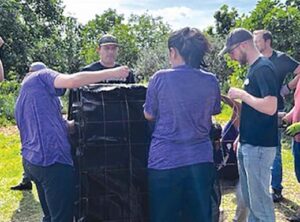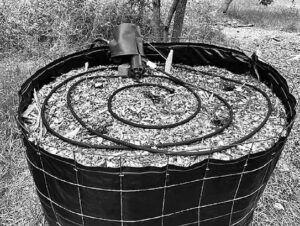Anyone involved with trying to maintain a charitable organization understands the problems. Money is always an issue, and a large portion of planning is to find ways to make things work without spending money.
Rosewood Community Orchard (RCO) deals with those issues regularly. McKenzie Scott and Karen Murphy, lead gardeners at RCO, are constantly brainstorming for new ideas to improve efficiency and cut costs. Along with Anne Burke, long time board member, they have been working on ideas to increase efficiency by improving the most basic ingredient involved in growing any kind of plant—the soil.
Acting on a promising tip from a source, Burke contacted Dr. Buz Kloot, who rides herd on the University of South Carolina’s Soil Health Labs, a small group making massive changes in the field of growing crops. Kloot was aware of a device that reduces work, mess, and expense for those unfortunate folks who normally go through the regular steps to create their own compost. Burke knew Kloot from a time when he coached her daughter’s swim team and contacted him about something called a bioreactor.
The first bioreactor is credited to David Johnson, a molecular biologist serving as a research scientist at the Institute for Sustainable Agricultural Research at New Mexico State University in Las Cruces. While working on an experimental project with Joe Ellington, Johnson found himself manipulating a lot of cow manure.
His wife, formerly Hui-Chun Su, grew tired of washing the extremely dirty clothes her husband was wearing home. Combining his molecular science background and her relentless drive, the couple invented the Johnson Su Bioreactor, which created fungal-dominant and biologically diverse compost. Their primary reason for the invention was to reduce labor involved in turning compost, along with reducing the smell and the fly population. This labor-saving device also reduced laundry time in the Johnson home significantly.
Burke, using the information from Kloot, began doing more than planning. Looking for something not quite so industrially sized, she began searching for a smaller version. A Jack Spirko YouTube video offered possibilities. Spirko is a jack-of-all-trades focusing on growing one’s own food. He took Johnson’s bioreactor and “got rid of everything he didn’t need.” He was building on a small scale and wanted something designed for a backyard gardener rather than a multi-acre food producer. This seemed to be the design Burke and RCO were looking for.
The design is simple and uses ordinary materials. It relies on dampness, air circulation, and time to ferment compost without having to constantly stir and turn the contents. This helps create a natural system of planting and growing food that humans long ago abandoned.
By adding a supercharged, fermented compost to the existing soil, and using ancient planting methods that focus on an entire ecosystem rather than modern substitutes like tilled soil and chemically based fertilizer, one can mimic the natural ways of growing plants that have existed for billions of years—at least that’s the plan. And so a group of volunteers assembled at the Rosewood Orchard, and this reporter was invited to document the event.
Capgemini has been providing a volunteer workforce to Rosewood Community Orchard for quite some time. Tayyaba Sadaq has been the primary contact for several years and organized the bioreactor volunteers as an Earth Day Project for Capgemini. Tayyaba and Matthew Obray coordinated the actual work force for this project.
Obray spent his early years and attended college in Utah. “Growing up I was always involved with community outreach whether through the church I went to or scouting.” He moved to the Columbia area after getting a job with Capgemini, a global leader in consulting, technology services and digital transformation.
Capgemini is at the forefront of innovation to address opportunities in the evolving world of the cloud and digital platforms. It is a multicultural company of 200,000 engineering team members in over 40 countries.
Capgemini is also an organization dedicated to sustainability. The company has an Employee Resource Group, OCEANS, that’s for people who are passionate about helping the planet. This group sponsored Capgemini’s Earth Day activities this year.
“When I started at Capgemini I joined an employee resource group, which has evolved into OCEANS. We have been able to do many projects including litter cleanups, Harvest Hope, helping United Ways with STEM nights at local elementary schools, and Earth Day. Helping to build this bioreactor is part of those Earth Day activities. OCEANS is always looking for opportunities to give back to our community and help our planet.”
Rosewood Community Orchard wouldn’t be operational without volunteers. USC’s Tom Syfert and his Home Works of America provide much needed labor for specific projects and support for the folks who regularly visit the place willing to work.
The OCEANS team was impressive. Watching this group of diverse young people with no link to this place other than the desire to help was special. There were no arguments, no one standing around waiting for someone else to take charge, and no one hiding in a corner complaining and eating avocado toast.
Fueled by snack bars and water, each necessary task was taken on with minimum discussion, maximum effort, and a coordination worthy of a veteran team performing a familiar task.
In a short time the bioreactor was taking shape, then transferred to a permanent location and filled with available composting materials and plenty of water. Completing an automatic watering system was necessary since no one lives in the orchard and daily watering is required. After 12 months of waiting, all those involved will find out how successful their project will be—and continue growing food.
For more information, visit columbiaresilience.org/?cat=4 or www.youtube.com/watch?v=yBugi5n8BwE&t=373s.




Loading Comments